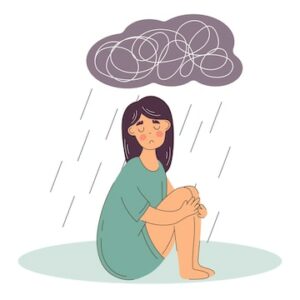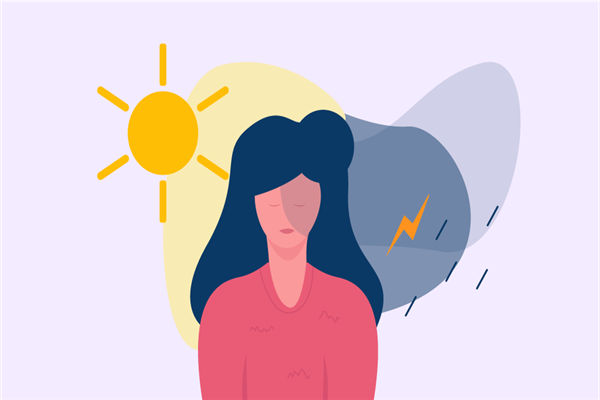It’s that time of year again. The leaves are changing colors, the temperature is dropping, and everything warm is back in season. For many people, this change in seasons means a change in mood. Some people experience a mild change in mood, while others experience a more extreme change called seasonal bipolar disorder. In this blog post, we will discuss what seasonal bipolar disorder is, its symptoms, and how to get help if you think you may be affected.
Contents
Defining Seasonal Bipolar Disorder
 The name may seem suggestive enough to answer our first question, what is seasonal bipolar disorder? It is a type of bipolar disorder that is characterized by changes in mood that correspond with changes in seasons. While the most common type of bipolar disorder is manic depression, which involves periods of extreme highs and lows, seasonal bipolar disorder only includes depressive episodes. These episodes generally start in the fall or winter and last until spring or early summer.
The name may seem suggestive enough to answer our first question, what is seasonal bipolar disorder? It is a type of bipolar disorder that is characterized by changes in mood that correspond with changes in seasons. While the most common type of bipolar disorder is manic depression, which involves periods of extreme highs and lows, seasonal bipolar disorder only includes depressive episodes. These episodes generally start in the fall or winter and last until spring or early summer.
This disorder has also been called seasonal affective disorder (SAD), winter depression, and summer depression. However, bipolar disorder and SAD are two distinct disorders. The main difference is that people with seasonal bipolar disorder experience more extreme changes in mood and energy levels than those with SAD.
Moreover, it is a relatively new disorder that was only recently added to the Diagnostic and Statistical Manual of Mental Disorders (DSM-V) in 2013. Before that, it was considered a subtype of major depressive disorder.
Signs And Symptoms
The signs of this disorder can be tricky and may even go unnoticed. This is because the symptoms are often mistaken for the blues or a low mood that is common during the fall and winter. However, there are some key differences between seasonal bipolar disorder and the winter blues.
- First, people with seasonal bipolar disorder experience much more extreme changes in mood. They may feel hopeless, sad, or irritable for long periods of time.
- They may also lose interest in activities that they normally enjoy and have trouble sleeping. These symptoms can last for weeks or even months at a time.
- Further, people with seasonal bipolar disorder often experience changes in energy levels and activity levels. They may feel fatigued and have low energy, even when they get enough sleep. They may also have trouble concentrating and may be more irritable than usual.
- Third, people with seasonal bipolar disorder may experience changes in weight or appetite. They may lose interest in food or may overeat. They may also gain or lose weight.
- Finally, people with seasonal bipolar disorder may have thoughts of suicide or self-harm. This is because the low mood can be so severe that it interferes with a person’s ability to function.
If you are experiencing any of these symptoms, it is important to seek help from a mental health professional.
Causes And Risk Factors
 A disorder as complex as seasonal bipolar disorder is likely caused by a combination of genetic and environmental factors.
A disorder as complex as seasonal bipolar disorder is likely caused by a combination of genetic and environmental factors.
First, there is a strong genetic component to this disorder. People with first-degree relatives (parents, siblings, or children) who have bipolar disorder are at a higher risk of developing the disorder themselves.
Second, there is an environmental component to this disorder. People who live in northern latitudes are more likely to develop seasonal bipolar disorder. This may be due to shorter days and longer nights during the winter months.
Additionally, your biological clock, also known as your circadian rhythm, may play a role in this disorder. This is the 24-hour cycle that regulates your sleep-wake cycle. disruptions to your circadian rhythm can lead to changes in mood and energy levels.
Since the human brain and body run on neurotransmitters and nutrients, it stands to reason that imbalances in these chemicals could also contribute to seasonal bipolar disorder. A lack of Vitamin-D or omega-fatty acids has been linked to this disorder.
Moreover, some other risk factors for this disorder include:
- Having another mental health disorder, such as anxiety or depression
- Having a history of substance usage
- Having a history of trauma or abuse
- Use of certain medications, such as corticosteroids
- Experiencing major life changes, such as starting a new job or getting married
It is important to note that one can develop seasonal bipolar disorder without any of these risk factors. This is why it is important to speak to a mental health professional if you are experiencing any of the above.
Diagnosis
SAD or seasonal bipolar diagnosis is a tricky business. This is because the symptoms are often similar to those of other mental disorders, such as major depressive disorder or generalized anxiety disorder.
Furthermore, the symptoms may only appear during certain times of the year, making it even more difficult to diagnose.
That being said, there are some key differences that a mental health professional will look for.
- First, they will ask about the severity and duration of your symptoms. They will also ask if your symptoms are worse during certain times of the year.
- Second, they will ask about your family history. As mentioned before, there is a strong genetic component to this disorder.
- Third, they will ask about your sleep patterns. People with seasonal bipolar disorder often have difficulty sleeping, even when they are not experiencing any other symptoms.
- Fourth, they will ask about your appetite. People with seasonal bipolar disorder often experience changes in appetite, either overeating or losing interest in food altogether.
- Finally, they will ask about your thoughts and feelings. People with seasonal bipolar disorder often have negative thoughts, such as thoughts of suicide or self-harm.
If you are experiencing any of these symptoms, it is important to seek help from a mental health professional.
Treatment Options
 There is no one-size-fits-all approach to treating seasonal bipolar disorder. This is because the disorder is unique to each individual. However, there are some treatment options that are effective for most people.
There is no one-size-fits-all approach to treating seasonal bipolar disorder. This is because the disorder is unique to each individual. However, there are some treatment options that are effective for most people.
The first step is to identify the trigger. This may be something like shorter days or longer nights. Once the trigger is identified, it can be addressed accordingly.
For example, if shorter days are the trigger, then light therapy may be recommended. Light therapy involves exposure to artificial light for a set period of time each day. This can help to regulate your circadian rhythm and improve your mood.
If longer nights are the trigger, then sleep hygiene may be recommended. Sleep hygiene is a set of habits that can help you to get a good night’s sleep. These habits include things like avoiding caffeine before bed and establishing a bedtime routine.
In addition to addressing the trigger, there are some other treatment options that can be effective. These include:
- Cognitive behavioral therapy: This type of therapy can help you to change the negative thoughts and behaviors that are associated with seasonal bipolar disorder.
- Medication: There are several types of medication that can be effective for treating seasonal bipolar disorder. These include antidepressants, mood stabilizers, and antipsychotics.
- Electroconvulsive therapy: This is a treatment that involves passing electrical currents through the brain. It is typically used as a last resort when other treatments have failed.
If you are experiencing symptoms of seasonal bipolar disorder, it is important to seek help from a mental health professional. With proper treatment, it is possible to manage the disorder and live a healthy, happy life.
Conclusion
To summarize, we can say that seasonal bipolar disorder is a type of mental disorder that is characterized by changes in mood and behavior. The symptoms typically appear during certain times of the year, such as shorter days or longer nights. There is no one-size-fits-all approach to treating the disorder, but there are some treatment options that are effective for most people. If you are experiencing symptoms of seasonal bipolar disorder, it is important to seek help from a mental health professional. With proper treatment, it is possible to manage the disorder and live a healthy, happy life.
If you or someone you know is looking for psychological help, Therapy Mantra is here for you. We are the leading providers of online therapy and counseling. Our team of highly trained and experienced therapists can provide assistance at the most affordable rates. Contact us today to learn more about our services. You may also visit our website to book an online therapy session or download our free Android or iOS app for more information.


